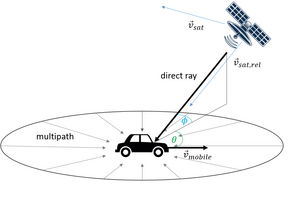
This clip (from the multimedia tutorial) shows a classic Doppler effect in sound from a moving source. A piezo-electric crystal emits a steady sound wave from the end of the handlebar of my bicyle. I approach the camera, whose microphone is fixed on a stand. A moving source
When a vehicle with a siren passes you, a noticeable drop in the pitch of the sound of the siren will be observed as the vehicle passes. This is an example of the Doppler effect. An approaching source moves closer during period of the sound wave so the effective wavelength is shortened, givinga higher pitch since the velocity of the wave is unchanged.
and aDoppler Effect Example Problem
fixed observer
Doppler Effect Example
- Example of Doppler Shift using car horn. If playback doesn't begin shortly, try restarting your device. You're signed out.
- The Doppler effect can be observed for any type of wave - water wave, sound wave, light wave, etc. We are most familiar with the Doppler effect because of our experiences with sound waves. Perhaps you recall an instance in which a police car or emergency vehicle was traveling towards you on the highway.
One clear effect is that the sound becomes louder as the bicycle approaches and softer as it recedes. No surprise here: we've analysed this in Travelling Waves II and Radiation in three dimensions.

The Doppler effect is the change in frequency: in the case of sound, we hear this as a change in pitch: while the bike approaches the microphone, the pitch and frequency are higher than when it is stationary, when it recededs the pitch and frequency are lower. 天降锦鲤 ~ my lucky koi download for mac.
Higher frequency means shorter period (see Oscillations to revise). On the sound track, three samples – the vertical red bars – are labelled: f for the stationary source, fv+ for approaching and fv− for receding. Best space cleaner app. Later, we define velocities to be positive an object is approaching and negative if receding, hence this notation. In the bottom three graphs, the three samples have been selected and the axes expanded. (The softer distant signals have also been amplified: their amplitude has been increased, to make them easier to see.)
The arrows show 25 periods. Remembering that f = 1/T, we see that fv+ > f > fv−: higher pitch on approach, lower pitch when receding. In this example, the proportional differences in frequency are only a few percent. We'll see later that this is because my speed is only a few percent of the speed of sound. However, most of us can hear this small change clearly – human hearing is very sensitive to frequency and musicians can easily notice fractions of a percent difference. Here the difference between approaching and receding is 5%, which we hear as a semitone. Chrome update 2020. (You may wish to run the clip again to check.)
Doppler Effect Example Problems

Doppler Effect Example In Sound

Doppler Effect Examples Video
- On a piano, all the semitones have frequency ratios of 5.9%. On most instruments, the size of a semitone can be varied according to musical context. 5% falls within this range, so we hear 5% as a semione, and some may notice that it is narrower than a piano's equal tempered semitone. (Note - frequency - note conversions here.)
